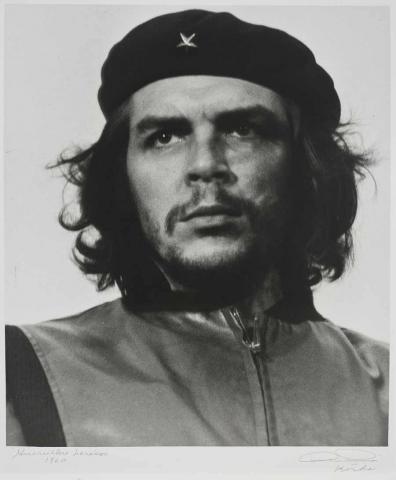
The lecture is scheduled Saturday, November 23, at 2 p.m. at the Jordan Schnitzer Museum of Art
EUGENE, Ore. -- (November 20, 2013) – In conjunction with the exhibition ”Korda and the Revolutionary Image,” University of Oregon professor Carlos Aguirre examines the legacy of Che Guevara in a lecture on Saturday, November 23, at 2 p.m. at the Jordan Schnitzer Museum of Art.
More than 45 years after his death in Bolivia, Che Guevara continues to both inspire efforts towards social justice around the world and spark fierce discussions about his life and legacy. The lecture will revisit his place in history and will provide a nuanced assessment of his political and cultural significance today.
Carlos Aguirre is a professor in the University of Oregon Department of History and director of the Latin American Studies Program. A social historian specializing in nineteenth- and twentieth-century Peru and Latin America, Aguirre has written extensively about slavery, abolition, crime, and punishment. His recent publications include Militantes, intelectuales y revolucionarios. Ensayos sobre marxismo e izquierda en América Latina (Raleigh: Editorial A Contracorriente, 2013); “Punishment and Extermination: The Massacre of Political Prisoners in Lima, Peru, June 1986,” in Eric A. Johnson, Ricardo Salvatore, and Pieter Spierenburg (eds.), Murder and Violence in Modern Latin America (London: Wiley-Blackwell, 2013); and “Tinterillos, Indians, and the State: Towards a History of Legal Intermediaries in Post-Independence Peru,” in Stefan B. Kirmse, ed., One Law for All? Western models and Local Practices in (Post-) Imperial Contexts (Frankfurt: Campus Verlag, 2012).
The exhibition “Korda and the Revolutionary Image” is on view in the JSMA’s Focus Gallery through January 26, 2014. Included in the exhibition is “Guerillero Heroico," Korda’s iconic image of Argentinian revolutionary Ernesto “Che” Guevara. On March 5, 1960, Korda attended a Havana memorial service for the 81 victims of the La Coubre explosion, during which he took several photographs of Castro as well as the French intellectuals Simone de Beauvoir and Jean Paul Sartre.
“At the foot of the podium draped in black crepe, my eye pressed to my old Leica, I was focusing on Fidel and the people around him. Suddenly, through the 90 mm lens, Che loomed above me,” Korda later commented. “I was surprised by his look. …. By reflex, I snapped twice—one horizontal shot and one vertical. I didn’t have enough time to take a third photo, as he stepped back discreetly into the second row….”
Korda’s images of Castro appeared the next day in the paper, but the now famous Che image hung in the artist’s studio for nearly a decade before being published. Seven years after the explosion, after Che was killed in Bolivia, the image quickly garnered global attention when it was printed in poster form by an Italian publisher and used by student protestors in the streets of Milan–and across the world. Korda’s photograph of Che has since become a universally recognized symbol of revolution and is believed to be the most reproduced photograph on earth and the second most reproduced image in the history of Western art (after Leonardo da Vinci’s Mona Lisa). Despite the fact that it is one of the most iconic images in the world, Korda always insisted that it was a “lucky break.”
The photographs are on loan from the Collection of Dr. Steve Pieczenik and Dr. Roberta Rovner Pieczenik and Family, Chevy Chase, Maryland. “Korda and the Revolutionary Image” is made possible by a JSMA Academic Support Grant.
About the Jordan Schnitzer Museum of Art
The University of Oregon's Jordan Schnitzer Museum of Art is a premier Pacific Northwest museum for exhibitions and collections of historic and contemporary art based in a major university setting. The mission of the museum is to enhance the University of Oregon’s academic mission and to further the appreciation and enjoyment of the visual arts for the general public. The JSMA features significant collections galleries devoted to art from China, Korea, Japan, America, Europe and elsewhere as well as changing special exhibition galleries. The JSMA is one of six museums in the state of Oregon—and the only university museum--accredited by the American Alliance of Museums.
The Jordan Schnitzer Museum of Art is located on the University of Oregon campus at 1430 Johnson Lane. Museum hours are 11 a.m. to 8 p.m. Wednesdays, and 11 a.m. to 5 p.m. Tuesdays and Thursdays through Sundays. Admission is $5 for adults and $3 for senior citizens. Free admission is given to ages 18 and under, JSMA members, college students with ID, and University of Oregon faculty, staff and students. For information, contact the JSMA, 541-346-3027.
About the University of Oregon
The University of Oregon is among the 108 institutions chosen from 4,633 U.S. universities for top-tier designation of "Very High Research Activity" in the 2010 Carnegie Classification of Institutions of Higher Education. The UO also is one of two Pacific Northwest members of the Association of American Universities.
Contact: Debbie Williamson Smith, 541-346-0942, debbiews@uoregon.edu
Links: Jordan Schnitzer Museum of Art, http://jsma.uoregon.edu
- Log in to post comments






